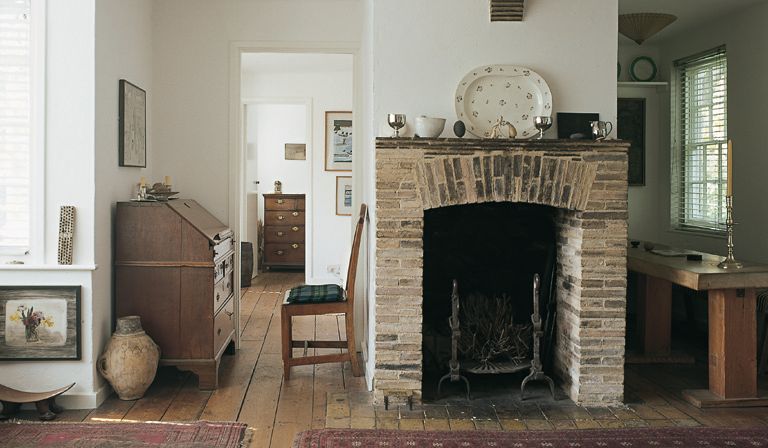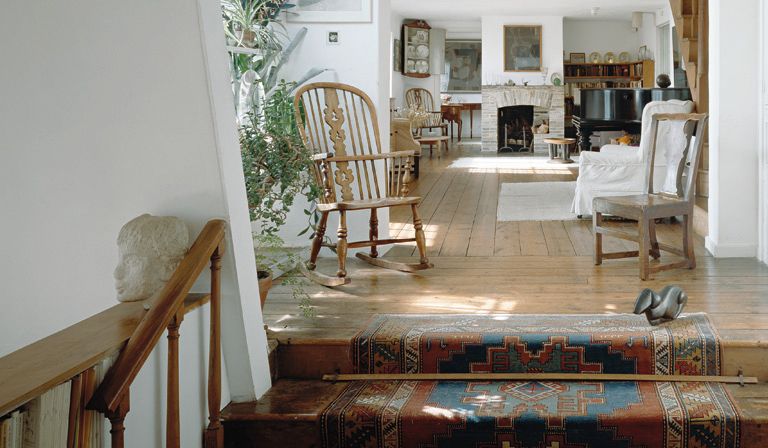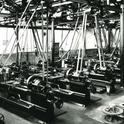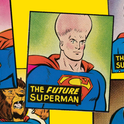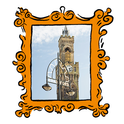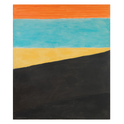My student room at Cambridge university was gloomy: low ceilings and dark wood and bare walls that nobody was permitted to sully with Blu Tack. There was a noticeboard, on which I made a forlorn display of postcards. But there was also a picture rail and, on the other side of the river, the Kettle’s Yard art gallery, once the home of a collector called Jim Ede, who died in 1990.
The gallery began life as four slum cottages, purchased by Ede in 1956 and turned into a home for himself and his art. He gave the house and its contents to the university in 1966, living on, a genial curator, amid its white walls and Turkish rugs, resisting the tastes and security systems of modernity. His collection was by then vast, a long amassing of beloved paintings and sculpture. Found objects, too: flints, feathers, a whorl of perfect pebbles, meticulously displayed.
The gallery ran and still runs a scheme allowing students to borrow pictures. Turn up on a particular day and the store cupboards are yours for the riffling. The actress Miriam Margolyes, studying at Cambridge in the early 1960s, managed to bag two works by Alfred Wallis, the Cornish fisherman and artist whom Ede never met, but whose passionate and sophisticated maritime paintings—done in naive style on scraps of cardboard—he purchased obsessively. No Wallises were to be had when, half a century later, I flicked through dusty frames and selected an explosion of many-coloured dots and a composition of navy and ochre slabs, thickly painted on a gritty background divided in two, one half dark, the other light. Both were mine for a year, for a cash deposit. I didn’t have the money in my account. I rang my mother.
The splatter of dots was a screenprint by Ian Stephenson, one of his Phoenix set; the ochre and navy slabs were John Blackburn’s Male and Female, 1964 (January). Ede befriended Blackburn in the early 1960s and I can see why the title of “my” painting, rendering representational what had seemed abstract, appealed to him. “Jim could anthropomorphise a teacup,” Laura Freeman says in this, the first book-length account of Ede’s life. Surveying Ben Nicholson’s 1925 (jar and goblet), he thought it was a painting about friendship.
Friendship was vital to Ede. A footnote in other biographies, he is a risky choice for one of his own: curator and critic, never wholly successful at anything bar housing and helping art and artists, he could seem less interesting than the names in his address book. Virginia Woolf, characteristically catty, thought him a “complete imbecile”; her sister, Vanessa Bell, considered him an “amiable zanie”. It is Freeman’s triumph that Ways of Life succeeds. Living for art, it turns out, is an art in itself.
Jim Ede—born Harold, the son of a solicitor—tried many different ways of life. He made inconsequential attempts to become a painter before serving in the Flanders trenches. “Flash after flash,” he wrote, “boom after boom, mud & stones rocketing from the sucked earth, the world a rattle of continuous clamour.” By the 1920s he was assistant curator at what became the Tate Gallery, battling with those above him in his tireless promotion of the contemporary (Picasso, Van Gogh). He was one of those people perpetually short of money who are always able to find more of it. The times allowed for his obsessions. Freeman notes that his grand Hampstead house, purchased for £5,000 and soon a salon for every budding interwar artist, would cost him over £6m today. He was something of a conjuror, forever pulling masterpieces out of a suitcase or carrying them home on the crowded Underground.
Ede was one of those people perpetually short of money who are always able to find more of it
He is a contradictory and elusive subject, the altruism of the benefactor scraping against the selfishness of the obsessive. He spent a lot of time galloping about: buying, selling, renovating, fundraising, lecturing, employing what his father once called “his uncanny genius for WANGLING”. Prior to Cambridge, he made homes in India, Morocco, America and France. Freeman—the chief art critic for the Times—gallops after him. It is more his fault than hers when the narrative tumbles into itinerary and inventory. She herself is a collector and gatherer, swooping like a magpie on glints of detail. This is a life not written up but curated, laid out in objects: the Queen Anne desk Ede bought when he was 12, for £8; a tiny ring, given to him by the American artist Richard Pousette-Dart, which he wore as a charm on his watchstrap; his ivory hairbrushes, once owned by a friend of John Keats.
The endnotes are swagged with catalogue numbers, the book born of submergence in a near-illegible archive of letters. Freeman has imbibed the facts to the extent that she seems to offer Ede’s world as a product of her imagination, hitting exactly the right tone of thoughtful, critical affection. This is biography as self-portrait, seen from its subject’s viewpoint. Ede’s parents are “Mother” and “Da”. The witty sentences are fine things, illuminating and illumined, conveying the way light is bounced around Kettle’s Yard as it shines from candlesticks and picture frames or casts rainbows onto a Brâncuși sculpture or Bechstein piano.
On Ede’s private and inner life the book is brisk. He married a beauty, Helen Schlapp, whom he had met in Edinburgh when both were students at the city’s College of Art; they had two daughters. But, as Freeman states: “Jim’s romantic attachments were to men.” The nature and objects of these attachments are not revealed and, appearing halfway through, the sentence frustratingly recasts all that has gone before. Freeman sensibly refuses to give in either to prurient speculation or to a contemporary urge for identity that Ede would not have recognised. But what is dispatched here in a few pages could be at the heart of another study.
Ede was gifted in loving and looking, and usually one became the other. It seems he disapproved of sex between men; he found other ways to make love. “I’ve been holding your pebble in my hand all this last two hours,” he wrote to Pousette-Dart. “It feels hot within my hand…” His love was tugged in different directions: devotion to his wife, attraction to men, and dedication to art, its fostering and funding. Wondering if he could buy a Van Gogh, he regretted that he had a “wife and child to keep”. Birthdays are missed; his daughter’s piano lessons cancelled to raise funds for Alfred Wallis. If the pram in the hall is the enemy of good art, as the literary critic Cyril Connolly argued, is it the enemy of purchasing good art, too?
Ede thought most houses were “hurricanes”, seeking in his own interiors an “impression of spareness”. Ways of Life is a hurricane, too, dense with people and hung with pictures (Freeman’s publishers have done her proud). The book is marketed and subtitled as a group biography—although “the Kettle’s Yard artists” do not formally exist until Ede establishes the gallery, 70 pages before the end. Freeman loosely fashions each chapter from an artwork or object, spinning a cobweb of other lives around her central figure. The effect is of attending one of his raucous parties, knowing the famous faces, half-recognising others, never sure whom you have met before.
Here is Barbara Hepworth, “slight, steely and singular”; here TE Lawrence, once of Arabia, “short, stocky and lantern-jawed”; here artist-poet David Jones, valetudinarian, reeking of chest rub, his trousers held up with string. On it goes. Ben and Winifred Nicholson. The painter Christopher Wood, dead at 29 after jumping beneath a train. Alfred Wallis, dead at 87 after being moved to the workhouse. Sculptor Henri Gaudier, killed in the First World War, and the subject of a biography by Ede, called Savage Messiah.
The book’s weakness is crowd control. In chapter seven, which is not five pages long, Freeman names some 75 individuals. Overcrowding leads to structural uncertainty, revealing the architectural difficulty of cramming so many lives into one volume. The sentence relaying Gaudier’s death appears twice, all but identically, not 30 pages apart. That Winifred Nicholson was initially more famous than her husband Ben may be worth repeating; that Ede “read and re-read” Henry James is not. Four times we are told that David Jones lived with Eric Gill at Capel-y-ffin in Wales; five times that Ede had a taste for muesli. (He ate it from a Lucie Rie bowl.)
The clumsiness jars, given Ede’s passion for exactness: the placement of a pebble, a specific shade of white. He was “precise about spellings”, once enquiring of a young artist in spectacles, “is that Hockney with an E—or without?” Freeman, firmer on art than literature, talks of Gerald Manley Hopkins, rightly Gerard; of the Hawthorne Prize, rightly Hawthornden; and of Bleak House’s Mrs Jellby, rightly Jellyby. Only on minor details (dates, money, fatherhood) was Jim Ede slapdash. “His approach to titles was haphazard,” Freeman says. It’s a contagious imprecision. A poem by TS Eliot (either “Ash Wednesday” or the fourth section of “East Coker”) she rechristens “Good Friday”.
Ede’s was a life haunted by dust and water, those twin enemies of art galleries. To collect and curate was a means of restoring order and harmony to a world fragmented and destroyed. He remembered the “dirt & dust” of the camp beds on which he slept within Flanders mud. A massive flood at the Tate brought back memories of war, and he suffered periodically from nervous breakdowns and stomach trouble (hence the muesli). In 1943 it was falsely announced that, crossing the Atlantic, he and his wife had drowned when their ship was attacked.
In reality, he lived on to host wide-eyed students at Kettle’s Yard. He converted to Christianity and set up scholarships to fund “the joy of living”. Come the 1960s he could see from the Kettle’s Yard windows a newsagent’s, whose billboards he expected to carry news of nuclear attack. He had known fear in a handful of dust, but survived to see beauty in a spiral of pebbles.
The dust eventually became too much, however, settling like a blanket on the books and pictures. Ede decamped to Edinburgh in 1973, leaving Kettle’s Yard in the hands of a “resident” and playing backseat curator from afar. His was a way of life bestowed on others. The two paintings I borrowed from his collection brightened my room over a difficult year. He taught others a delight in careful looking. One canvas, Joan Miró’s Tic Tic from 1927, he displayed close to a pewter salver on which he then placed a single lemon, mirroring the yellow of a dot shining at the bottom-right of Miró’s picture. The lemon, routinely replaced, is still there. Once, a senior curator went out to purchase a new one and, returning triumphant, was ticked off by a long-serving volunteer. It was the wrong yellow.

